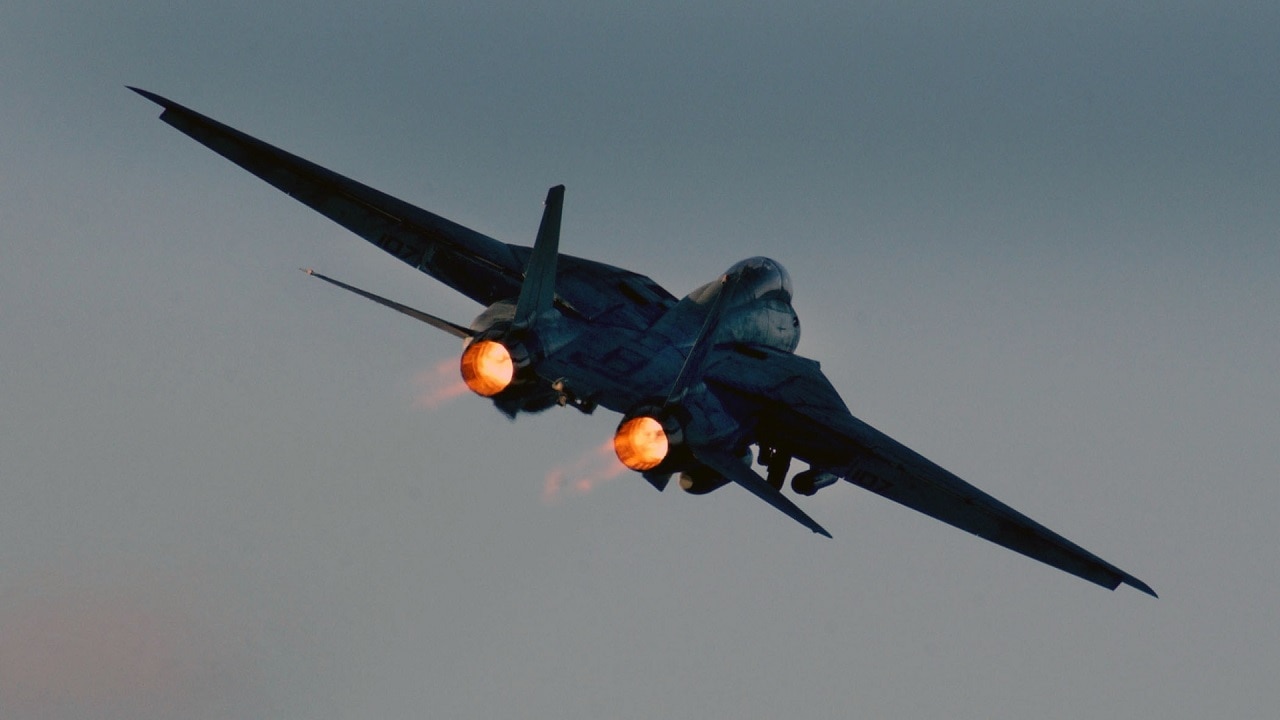SOLE PROPERTY OF THE IRANIAN AIR FORCE
Meet The F-14 Tomcat: The Most Famous US Military Aircraft Ever?By Eli Fuhrman

F-14 Tomcat. Image Credit: Creative Commons.
The F-14 Tomcat only flies for Iran at this point, yes, which is strange. However, for many reasons, the Tomcat is quite famous–some of which involve a certain movie: The F-14 Tomcat is one of history’s most iconic military aircraft, in no small part as a result of its starring role in the original Topgun film. But in addition to its on screen heroics, the F-14 was a very capable combat aircraft that served the Navy faithfully for decades.
F-14 History
The Tomcat first flew in December 1970, and achieved initial operational capability as a carrier-based aircraft with the U.S. Navy in 1973 and was first deployed the following year. The F-14, along with the Air Force’s F-16 Fighting Falcon and F-15 Eagle, emerged following an examination of air combat performance during the Vietnam War. Following the halt in production of the F-111B, the Navy sent out a request for proposals as part of its Naval Fighter Experimental (VFX) program, which called for a tandem two-seat, air superiority fighter. Grumman was awarded the contract in 1969.
The F-14 Tomcat was designed to be capable of engaging enemy aircraft at night and in any weather condition utilizing its six Phoenix AIM 54A missiles, while its AWG-9 radar and advanced weapons control system allowed the F-14 to track up to 24 targets at a time while creating and implementing fire control solutions for six targets.
The aircraft’s variable-sweep wing design allowed for variable speeds, with the wings automatically adjusting in-flight, sweeping forward for low-speed maneuvers and take-off and backwards for supersonic flight.
The F-14 possessed a max speed of Mach 1.88 and a maximum range of up to 500 nautical miles, depending on its weapons package.
F-14 Goes to War:
The F-14 would claim its first confirmed kills in 1981, when U.S. President Ronald Reagan ordered Navy freedom of navigation exercises near the Gulf of Sidra in the Mediterranean, following persistent Libyan territorial claims over the area. Two Libyan Su-22 Fitters attempted to engage a pair of F-14s, with the Tomcats managing to down both of the attackers. History would repeat itself in 1989, with a flight of Tomcats downing a pair of Libyan MiG-23s.
During the 1990s, the F-14 would evolve to take on a new role, filling a gap in the Navy’s capability as a strike aircraft following the retirement of the A-6 Intruder. Modifications were made to the F-14 to improve its ground attack capabilities, and the F-14 “Bombcat” first saw action as part of Operation Deliberate Force in Bosnia, before also taking part in action against Iraq in 2003.
The Navy would eventually replace the F-14 with the F/A 18E/F Super Hornet. Today, the F-14 still sees service with the Iranian Air Force, which received 79 Tomcats in the 1970s.
Eli Fuhrman was an Assistant Researcher in Korean Studies at the Center for the National Interest and a recent graduate of Georgetown University’s Security Studies Program, where he focused on East Asian security issues and U.S. foreign and defense policy in the region.
The F-14 Tomcat only flies for Iran at this point, yes, which is strange. However, for many reasons, the Tomcat is quite famous–some of which involve a certain movie: The F-14 Tomcat is one of history’s most iconic military aircraft, in no small part as a result of its starring role in the original Topgun film. But in addition to its on screen heroics, the F-14 was a very capable combat aircraft that served the Navy faithfully for decades.
F-14 History
The Tomcat first flew in December 1970, and achieved initial operational capability as a carrier-based aircraft with the U.S. Navy in 1973 and was first deployed the following year. The F-14, along with the Air Force’s F-16 Fighting Falcon and F-15 Eagle, emerged following an examination of air combat performance during the Vietnam War. Following the halt in production of the F-111B, the Navy sent out a request for proposals as part of its Naval Fighter Experimental (VFX) program, which called for a tandem two-seat, air superiority fighter. Grumman was awarded the contract in 1969.
The F-14 Tomcat was designed to be capable of engaging enemy aircraft at night and in any weather condition utilizing its six Phoenix AIM 54A missiles, while its AWG-9 radar and advanced weapons control system allowed the F-14 to track up to 24 targets at a time while creating and implementing fire control solutions for six targets.
The aircraft’s variable-sweep wing design allowed for variable speeds, with the wings automatically adjusting in-flight, sweeping forward for low-speed maneuvers and take-off and backwards for supersonic flight.
The F-14 possessed a max speed of Mach 1.88 and a maximum range of up to 500 nautical miles, depending on its weapons package.
F-14 Goes to War:
The F-14 would claim its first confirmed kills in 1981, when U.S. President Ronald Reagan ordered Navy freedom of navigation exercises near the Gulf of Sidra in the Mediterranean, following persistent Libyan territorial claims over the area. Two Libyan Su-22 Fitters attempted to engage a pair of F-14s, with the Tomcats managing to down both of the attackers. History would repeat itself in 1989, with a flight of Tomcats downing a pair of Libyan MiG-23s.
During the 1990s, the F-14 would evolve to take on a new role, filling a gap in the Navy’s capability as a strike aircraft following the retirement of the A-6 Intruder. Modifications were made to the F-14 to improve its ground attack capabilities, and the F-14 “Bombcat” first saw action as part of Operation Deliberate Force in Bosnia, before also taking part in action against Iraq in 2003.
The Navy would eventually replace the F-14 with the F/A 18E/F Super Hornet. Today, the F-14 still sees service with the Iranian Air Force, which received 79 Tomcats in the 1970s.
Eli Fuhrman was an Assistant Researcher in Korean Studies at the Center for the National Interest and a recent graduate of Georgetown University’s Security Studies Program, where he focused on East Asian security issues and U.S. foreign and defense policy in the region.

No comments:
Post a Comment